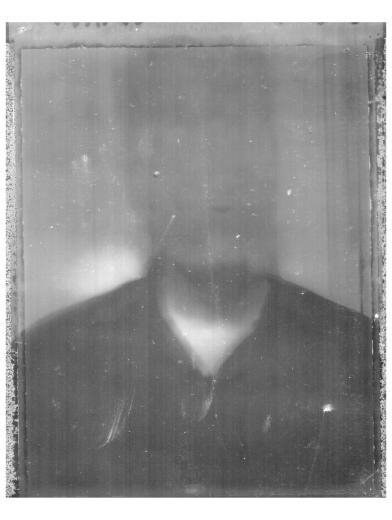Andre van Noord
Andre van Noord similarly takes on a wide range of subjects: flowers, decapitated fish, children, nudes, pregnant women, fields, cows, uniting in their exhibition to offer a humorous, sometimes dangerous game of association. Van Noord draws inspiration from his close environment, close friends and family, with studies of everyday life, the environment and people.
Light offers a consistent fascination for van Noord - in the glow of street lamps, light captured on tulip petals, the eery unreality of a long-exposed night-shot. In ‘Zelfs Als Molen’ van Noord photographs himself naked and waving on a nighttime street, creating a ghoulish and inscrutable picture. The artist brings to the fore the material, chemical reality of what a photograph is; images include the film’s border, negatives are scratched and dirtied, prints blurred and overexposed, developing a very physical photography. This physicality contributes to their emotional impact, investing them with a sense of age: they come with their own story, history, experience. This sense of capturing an essence, aura of his subjects is extended in his portraiture, be it of a nude or child, by an intimacy and trust which lends each an emotional verisimilitude.
Arno Nollen
In each case, Arno Nollen achieves an exposed, raw portrait of his model. Their poses are often stiff, arched, uncomfortable, especially when compared to those we recognise from both art and media. His frequent method of photographing a person head-on is very direct and confronting - it creates an objective feel of harshly documenting a person. This is especially true of the standing nudes; nudes usually are framed and posed in more ‘seductive’ and ‘acceptable’ composition. One connects his work to the photography of passports, high street clothing magazines, amateur porn.
What separates it, however, is Nollen’s understanding of light, setting, backdrop, coupled with his eye for understated hair and clothes. This unobtrusive sense of details ensures his work never feels insensitive or indiscriminate. Nollen makes his photographs in series and the works exhibited here explore vulnerability: the portraits of the old and young, alongside his pictures of women exposed and photographed so close and intimately that their eyes and expressions cannot be hidden or diguised, make for a stark study in vulnerability. His use of repetition, showing multiple images from a shoot, emphasises both similarities and differences: how slight changes in expression or posture can alter our reading. And, whether it is fascination, lust, disapproval, disquiet, this repetition serves to reinforce our response.
